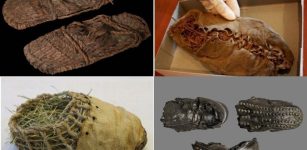Ancient Egyptian Toys And Games In Focus
Ellen Lloyd - AncientPages.com - Ancient Egyptians did not differ much from us when enjoying playing with toys and games. Board games were widespread in ancient Egypt, and people from all levels of society played them.
Archaeologists have discovered many board games used in ancient Egypt, but no explaining rules on how to play the games have survived. So, we have only guessed how the games were played. Some ancient Egyptian games were traditional African games, and others were learned from West Asian neighbors.
Ancient Egyptian Game Of Senet And Other Board Games
The Senet that translates to “game of passing” was ancient Egypt's most popular game board. The oldest hieroglyph representing a Senet game dates to around 3100 BC. The original rules of the Senet are unknown because no records of the rules have ever been discovered. With the help of images found on ancient tomb walls and actual artifacts, some have attempted to reconstruct the rules.
Based on what we know, the game of Senet was played by two people, either on elaborate carved and inlaid boards like the one found in Tutankhamen’s tomb or simply scratched into the earth. The Senet gameboard is a grid of 30 squares, arranged in three rows of ten.
A game box and pieces for playing the game of Senet found within the intact KV62 tomb of King Tutankhamun. This object is today part of the permanent collection of the Cairo Museum of Egypt. This photo was taken at the King Tut exhibition at the Pacific Science Center in Seattle, Washington State, USA. Image credit: Dmitry Denisenkov
Some of the squares had symbols on them, and the path of the counters probably followed a reversed S across the board. The symbols represented either good or bad fortune and affected the play accordingly. The movement of the counters was decided by throwing four two-sided sticks or, in some cases, knucklebones.
Good luck was a blessing from the gods, and the winner was the first to pass into the afterlife by getting all their pieces off the board.
Painting in the tomb of Egyptian Queen Nefertari (1295–1255 BC).
Another board game thought to have come from Asia was twenty squares. Several boards have been discovered, and it is known that the game was played by two players using five pieces, but just as in the case with the Senet board game, the rules of this game are now lost.
Ancient Egyptians also played with knucklebones.
There were several games that more than two people could play. In the game of "snake" (mehen), up to six people could play. It used a long field scratched out on the floor and stone pieces in the shape of dogs, lions, and balls that were moved along it. In yet another game, pegs with their tops shaped into dogs, jackals, and other animals were stuck into a row of 30 to 60 holes drilled into the board.
Ancient Egyptian dice. Image credit: Louvre Museum
Ancient Egyptian Toys For Kids
Ancient Egyptian children played different games with balls and dice, but they also had several toys, and some of them were very complex. Balls were made out of papyrus or leather, with straw stuffing. When horses were introduced to Egypt, horsehair was used for various games, including juggling.
Many fine examples of wooden and clay mechanical string toys have been found in the tombs of Ancient Egypt. The original of this particular wooden crocodile is believed to be from 1100 BCE and is on exhibit at the East Berlin Museum.
Some anthropologists believe these "toys" to be funerary objects placed in tombs to protect people in their next lives. The crocodile was a creature feared by many Egyptians and was commonly mummified and used to symbolize the god Sebek. The paddle doll, also from Ancient Egypt, is on display in the British Museum. The doll's hair is of sun-baked clay strung on flax thread. The doll's body is of wood and decorated with fertility motifs common to that era.
There are also many great examples in the Metropolitan Museum in NY. In 1887, the British archaeologist Flinders Petrie discovered an Egyptian doll factory dating to 1800 BCE.
The ancient Egyptian kids had clay rattles and little animals shaped out of clay. If parents could afford it, a child could also get wooden toys. Some wooden toys had moving parts, like a hippopotamus with jaws that could open and close.
Many fine examples of wooden and clay mechanical string toys have been found in the tombs of Ancient Egypt, and hopefully, archaeologists will excavate even more ancient Egyptian games and toys soon, so we will be able to learn more about the practices and various kinds of entertainment popular among ancient Egyptians.
Written by - Ellen Lloyd – AncientPages.com
Copyright © AncientPages.com All rights reserved. This material may not be published, broadcast, rewritten or redistributed in whole or part without the express written permission of AncientPages.com
More From Ancient Pages
-
 Largest Ancient Gold Treasure Of Its Kind Discovered In Stavanger, Norway
Archaeology | Sep 7, 2023
Largest Ancient Gold Treasure Of Its Kind Discovered In Stavanger, Norway
Archaeology | Sep 7, 2023 -
 1,000 Bog Bodies From Across Scandinavia Reveal More Ancient Secrets – Here’s What Scientists Found
Archaeology | Mar 20, 2023
1,000 Bog Bodies From Across Scandinavia Reveal More Ancient Secrets – Here’s What Scientists Found
Archaeology | Mar 20, 2023 -
 Mystery Of A 5,000-Year-Old Mass Grave In Poland Reveals A Family Tragedy
Archaeology | May 14, 2019
Mystery Of A 5,000-Year-Old Mass Grave In Poland Reveals A Family Tragedy
Archaeology | May 14, 2019 -
 Mystery Of The Hidden Wooden Hieroglyphic Tablets And The Unknown White Bearded Men – The Vatican – Part 1
Featured Stories | Mar 2, 2021
Mystery Of The Hidden Wooden Hieroglyphic Tablets And The Unknown White Bearded Men – The Vatican – Part 1
Featured Stories | Mar 2, 2021 -
 Unsolved Mysteries Of Cahokia – What Really Happened With The Large Metropolis?
Civilizations | Jan 15, 2015
Unsolved Mysteries Of Cahokia – What Really Happened With The Large Metropolis?
Civilizations | Jan 15, 2015 -
 Oldest Lunar Calendar Engraved On A Pebble Dated To 10,000 Years Ago
Archaeology | Aug 5, 2019
Oldest Lunar Calendar Engraved On A Pebble Dated To 10,000 Years Ago
Archaeology | Aug 5, 2019 -
 Controversial Hollow Earth Theory – Startling Discoveries And Different Conclusions – Part 2
Ancient Mysteries | Jun 25, 2019
Controversial Hollow Earth Theory – Startling Discoveries And Different Conclusions – Part 2
Ancient Mysteries | Jun 25, 2019 -
 Large Earthwork At Wichita Site In Kansas – Is It Long-Lost Native American City Of Etzanoa?
Archaeology | Sep 4, 2020
Large Earthwork At Wichita Site In Kansas – Is It Long-Lost Native American City Of Etzanoa?
Archaeology | Sep 4, 2020 -
 Unsolved Mystery Of The Giant Footprints Outside The Ain Dara Temple
Featured Stories | Jun 7, 2014
Unsolved Mystery Of The Giant Footprints Outside The Ain Dara Temple
Featured Stories | Jun 7, 2014 -
 Rare 2,700-Year-Old Seal Of Biblical King Jeroboam II’s Servant Confirmed Authentic
Artifacts | Jan 18, 2021
Rare 2,700-Year-Old Seal Of Biblical King Jeroboam II’s Servant Confirmed Authentic
Artifacts | Jan 18, 2021 -
 1,700-Year-Old Statue OF Greek God Pan Unearthed In Istanbul
Archaeology | Jun 9, 2023
1,700-Year-Old Statue OF Greek God Pan Unearthed In Istanbul
Archaeology | Jun 9, 2023 -
 Göbeklitepe-Like Kahin Tepe Is Oldest Worship Place In Black Sea Region – Interesting Finding
Archaeology | Sep 30, 2020
Göbeklitepe-Like Kahin Tepe Is Oldest Worship Place In Black Sea Region – Interesting Finding
Archaeology | Sep 30, 2020 -
 Blackfoot People Carry DNA From Unknown Ancestors Who Came To America 18,000 Years Ago
DNA | Apr 4, 2024
Blackfoot People Carry DNA From Unknown Ancestors Who Came To America 18,000 Years Ago
DNA | Apr 4, 2024 -
 Controversial Ancient Tomb Could Prove The Existence Of Biblical Jonah
Archaeology | Mar 9, 2014
Controversial Ancient Tomb Could Prove The Existence Of Biblical Jonah
Archaeology | Mar 9, 2014 -
 World’s Oldest Shoes: Some Look Surprisingly Modern
Artifacts | Jun 22, 2023
World’s Oldest Shoes: Some Look Surprisingly Modern
Artifacts | Jun 22, 2023 -
 Legend Of Brigadoon: Mythical Village Where Time Stands Still
Featured Stories | Nov 2, 2016
Legend Of Brigadoon: Mythical Village Where Time Stands Still
Featured Stories | Nov 2, 2016 -
 ‘Tonina Chiapas’ Mayan Pyramid In Southern Mexico Is Among The Largest Yet Found
Civilizations | Oct 29, 2018
‘Tonina Chiapas’ Mayan Pyramid In Southern Mexico Is Among The Largest Yet Found
Civilizations | Oct 29, 2018 -
 Stone Age People Used Human Bones For Making Pendants
Archaeology | Jul 6, 2022
Stone Age People Used Human Bones For Making Pendants
Archaeology | Jul 6, 2022 -
 Mysterious Runic Inscription Found In Mighty Viking Ship Burial Surprises Archaeologists
Vikings | Mar 25, 2025
Mysterious Runic Inscription Found In Mighty Viking Ship Burial Surprises Archaeologists
Vikings | Mar 25, 2025 -
 Humans In Africa Fled To The Mountains During The Last Ice Age
Archaeology | Aug 9, 2019
Humans In Africa Fled To The Mountains During The Last Ice Age
Archaeology | Aug 9, 2019





